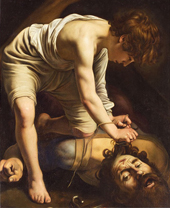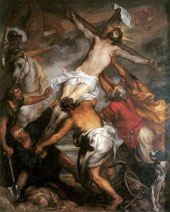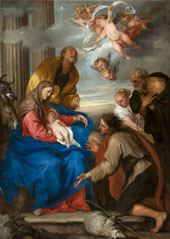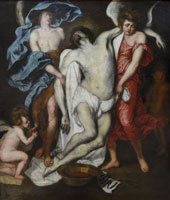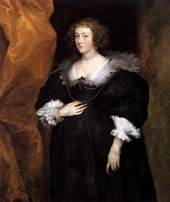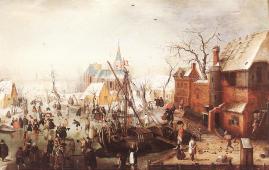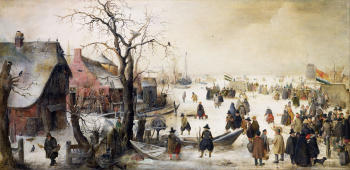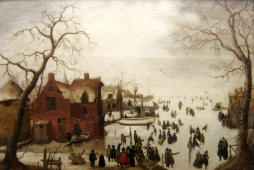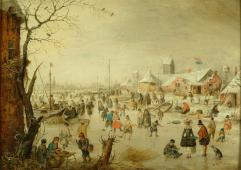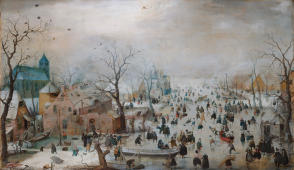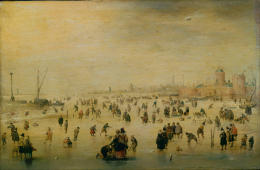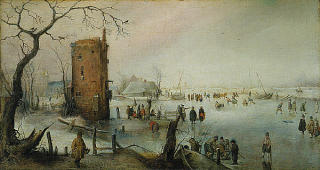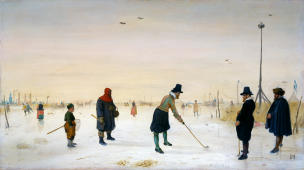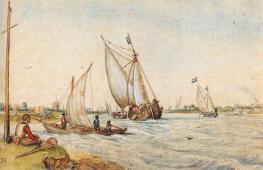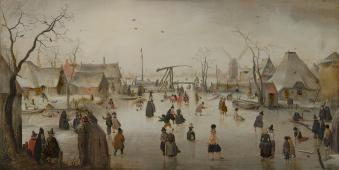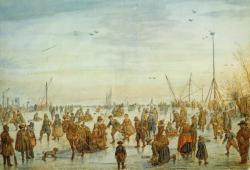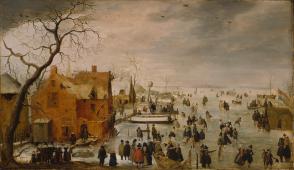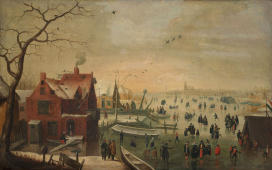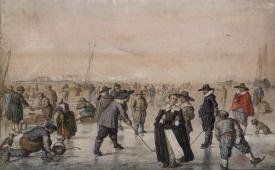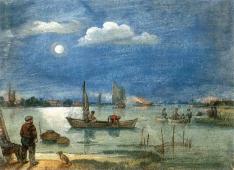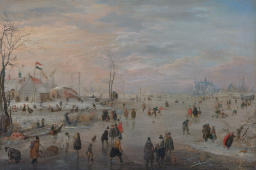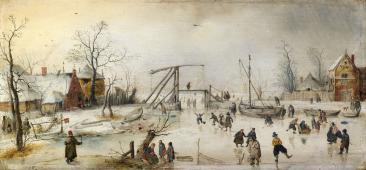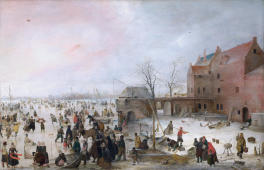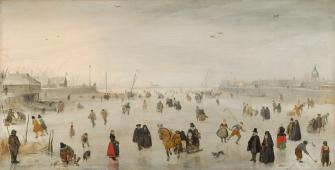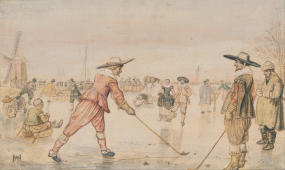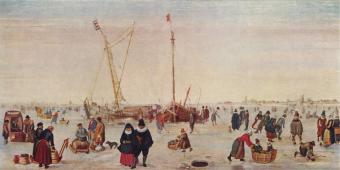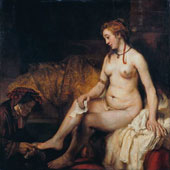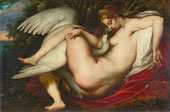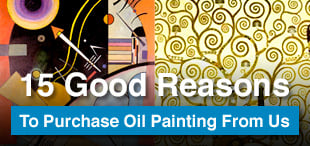Baroque Artists Oil Painting Reproductions
Find Baroque Artists oil painting replicas by Baroque Artists
Baroque Artists: An Introduction
Baroque artists were prominent during the 17th century. Baroque paintings transformed art and architecture, primarily characterized by a self-confident artistic bravura, dynamic movement, and realistic technique. The word “baroque” literally translates as “irregular shape” of pearls. Like many artistic movements, it initially met with opposition. The term Baroque originally critiqued painters moving away from highly controlled classical compositions. However, disapproval quickly transformed into praise in the years following its inception.
A Background to Baroque Religious Art
The Catholic Church heavily encouraged Baroque paintings as part of the counter-reformation. These awe-inspiring masterpiece paintings reinforced the superiority of the Church in Europe and helped suppress the new Protestant religion. Consequently, many Baroque paintings are spiritual Religious Art. While the style reached its zenith in Rome between 1630 and 1680, many Baroque artists were spread across Europe. Famous Baroque art in the Netherlands comes from Peter Paul Rubens paintings, Sir Antony Van Dyck in Britain, and Diego Velazquez in Spain.
Given its astounding geographical reach, it is worth exploring what defines Baroque period art before looking at some famous examples of the genre.
What are Baroque Paintings?
Baroque art lasted from the early 1600s until the late 1700s. Particularly popular in Rome, Baroque paintings spread into Holland, Spain, Germany, the UK, and France. It consequently inherited many Renaissance oil painting traditions and countered Protestant austerity and simplicity in art and architecture. Indeed, in the aftermath of Martin Luther’s 95 Theses and the resultant church schism, the Catholic Church believed art could serve as a valuable way to appeal to the masses. Baroque artists celebrate a form of religious self-expression and communication, emphasizing splendor, complexity, awe, and wonder.
With its strong religious background, many Baroque artists favored Religious Art with a clear message. In addition, dark backgrounds contrast against light figures with a powerful sense of movement, furthering the narrative aspects of Baroque style painting. Immensely popular in the middle of the 17th century, Baroque paintings gradually faded from the more theatrical and fluid Rococo style. Even so, Rococo was surpassed by the structure and control of Neoclassicism in the late 18th century.
What is the definition of Baroque paintings?
Baroque artists fundamentally appeal to contrast, movement, and detailed principles. They oppose earlier Renaissance oil paintings with principles of stillness and stability. Indeed, Baroque paintings aim to surprise and awe their audiences. Accordingly, Baroque artists often chose warm colors and gold, contrasting against dark backgrounds. In addition, using the three primary colors heightens the sense of drama. In terms of the content of these paintings, Baroque paintings also focus on the moment of most intense drama. They contrast with earlier Renaissance paintings, often depicting rising tension before an event. Overall, Baroque art aims to evoke passion and emotions in viewers, using art as a genuinely communicative medium.
Within these broad characteristics, however, there were significant local variations. For instance, Dutch Baroque artists often focused on secular subjects, group portraits, landscapes, and still life over religious art. Italian old masters often painted highly narrative Biblical scenes, while Spanish Baroque paintings refer to royal and ecclesiastical patronage.
In summary, the characteristics of famous Baroque paintings are:
- Intensely dramatic and emotive scenes
- A narrative or moral focus
- Religious or classical themes
- The use of vibrant primary colors
- Chiaroscuro (contrasting light and dark tones)
If you’re searching for famous examples of Baroque art, here are ten famous paintings created by some of the greatest Baroque artists. Explore this fascinating and diverse style from Caravaggio artworks to Dutch artist Rubens and paintings by Vermeer.
Caravaggio Baroque Paintings
- Caravaggio, Judith Beheading Holofernes 1599
Although technically painted just before the Baroque period, Judith Beheads Holofernes by Caravaggio reflects the fundamental qualities of the style. Among all Baroque artists, Caravaggio pioneered chiaroscuro, contrasting light with dark moments and extreme drama. This painting, depicting the moment Judith severs Holofernes’ head, is astounding and powerful in its violence and painterly skill. - The Calling of St Matthew c1600 by Caravaggio
Similarly to Judith Beheading Holofernes, many paintings by Caravaggio depicted religious narratives. For example, the Calling of St Matthew represents the moment Christ inspired Matthew to become a disciple. Commissioned by Cardinal Matthew Contarelli, it also places the holy action directly in a secular setting. The men’s lavish dress contrasts with Christ’s bare feet. Their gloomy world of monetary concerns further juxtaposes faith's literal and figurative illuminating light. - Supper at Emmaus 1601 by Caravaggio
Also commissioned by Cardinal Contarelli, Supper at Emmaus followed The Calling of St Matthew’s fame and success. Painted at the height of Caravaggio’s fame, it cemented his reputation amongst Baroque artists of the age. Depicting Christ sharing an evening meal with two of his disciples epitomizes the dramatic moment of revelation when two men realize they are in the company of the Lord.
Rembrandt Baroque Paintings
- The Night Watch 1642 by Rembrandt
This oversized canvas is a true Dutch Baroque art masterpiece and the most famous Rembrandt painting. Like much northern European Baroque art, The Night Watch painting depicts a secular, as opposed to religious or classical, theme. The militiamen of Amsterdam’s civic guard appear out of the nocturnal darkness. Rembrandt’s extraordinary use of light picks out specific details, such as the captain’s commanding hand and the young girl’s surprised expression, encouraging the viewer’s gaze to move around the composition. - Rembrandt van Rijn, Return of the Prodigal Son c1669
The Prodigal Son by Rembrandt completes this list of famous Baroque paintings. This religious painting represents the true artistic culmination of the Baroque art period, with Rembrandt's painting depicting a moment of extreme emotional resonance. Each character enigmatically emerges from the dark background, and a father tenderly forgives his errant son. The great art historian, Kenneth Clark, described it as “the most outstanding picture ever painted, " it is an unparalleled representation of spiritual and familial compassion.
Velazquez Baroque Paintings
- Diego Velasquez, Portrait of Innocent X 1650
Amongst Spanish Baroque artists, Diego Velasquez is one of the most celebrated and admired artists. His Portrait of Pope Innocent X is in Rome's prestigious Doria Pamphilj Gallery. This portrait painting is acknowledged as the most nuanced portrait ever created, celebrating Velasquez’s fantastic painterly realism. In addition, the portrait provides an unflinching insight into the strong personality of this highly intelligent yet aging pontiff. - Las Meninas 1656 by Diego Velazquez.
Velazquez's paintings are known for their drama and mystery. Las Meninas is no exception to this rule. It is also exemplary for its use of light and shadow. Diego Velazquez peers behind a monumental canvas while light and jewel-like colors highlight the infanta, Margaret Theresa. The King and Queen of Spain are visible in the mirror at the back of the room, adding drama and intrigue to this fascinating group portrait painting.
Johannes Vermeer Famous Baroque Paintings
- Johannes Vermeer, Girl with a Pearl Earring c1655
Vermeer's painting, Girl with the Pearl Earring, stands the test of time. As well as a much-discussed enigmatic portrait, the work reveals Vermeer’s expert Baroque stylings. While not usually classed primarily as a Baroque painter, Vermeer uses rich contrasting colors to a great extent. The lapis lazuli blue is juxtaposed with the dark background, providing an almost religious reverence to this deeply mysterious secular work. - Johannes Vermeer, The Milkmaid c1658
- Vermeer's painting The Milkmaid is another example of a secular Baroque painting from the Dutch Golden Age. Like Girl with a Pearl Earring, paintings by Vermeer frequently depicted everyday scenes in urban settings. The artist uses rich colors contrasted against a monochrome background making this a notable oil on canvas painting. The young woman pours milk into a bowl in a humble kitchen. Despite its low domestic setting, the Rijksmuseum in Amsterdam refers to the painting as “unquestionably one of the museum’s finest attractions.”
Peter Paul Rubens Baroque Artist
The Judgement of Paris 1638 by Peter Paul Rubens. This is one of his most famous oil paintings. Portraying a critical moment in classical mythology, it shows Paris judging a beauty contest between Minerva, Juno, and Venus. The nude, masculine Paris awards the ultimate prize to Venus. His arm extends to offer her the golden apple, a fateful and dramatic event leading to the eventual destruction of Troy.
Although Baroque paintings eventually gave way to Rococo and Neoclassical styles by the early 18th century, they experienced a resurgence in popularity during the 20th century. In the intervening years, Baroque artists have remained a consistent favorite. It is now an art movement rightly appreciated for its unique ability to express emotion alongside extreme painterly skill. But, as any art lover will gladly testify, Baroque paintings still hold power to shock and delight.
Replica Art of the Baroque Period
Do you enjoy the extravagance of Baroque paintings? Buy fine art reproductions of some of the most famous Baroque paintings. You can also discover Religious paintings for sale by artists of the 17th century. Similar oil paintings can be found in our list of Famous Oil Paintings.
Cannot Find What You Are Looking For?
Reproduction Gallery Information
Customer Service
(Send Us A Message)
Tel: (503) 937 2010
Fax: (503) 937 2011


